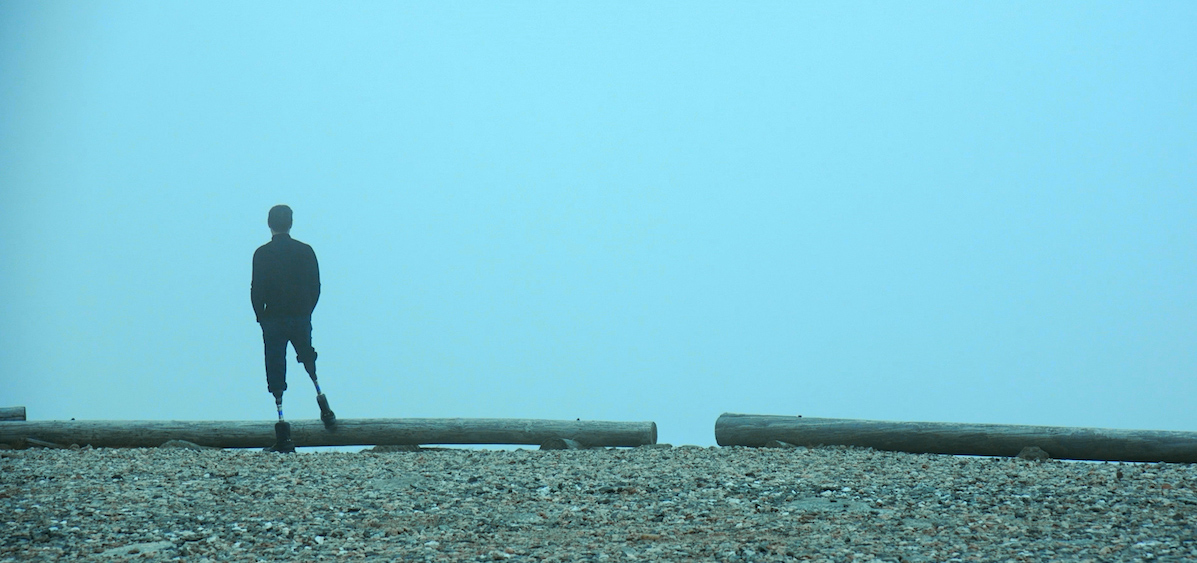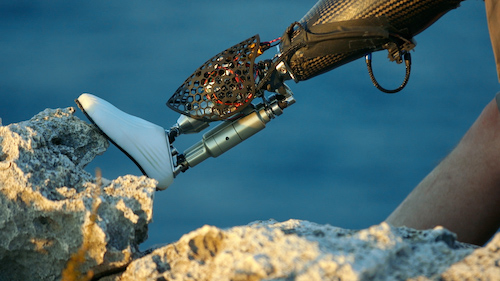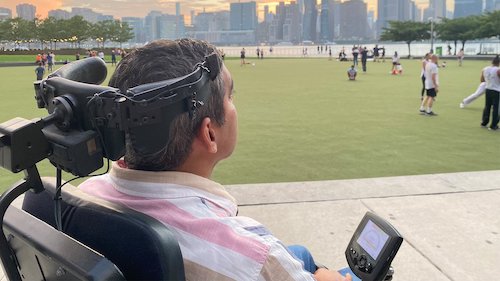Communiqué

Ingenious new technology allows prosthetic legs to move and feel like the real thing in “Augmented” on NOVA, Feb. 23 at 9pm
< < Back to ingenious-new-technology-allows-prosthetic-legs-to-move-and-feel-like-the-real-thing-in-augmented-on-nova-feb-23-at-9pmNOVA PRESENTS “AUGMENTED,” A PERSONAL STORY OF HOW TRAGEDY-INSPIRED SCIENTIFIC INNOVATIONS ARE TRANSFORMING THE FUTURE OF PROSTHETICS
One-Night, Two-Hour Special Broadcast Includes the 90-Minute Feature Film “Augmented” Followed by Documentary Short “Predicting My MS”
Premieres Wednesday, February 23, 2022, at 9 p.m. ET on PBS
On February 23, 2022, the award-winning PBS science series, NOVA, will premiere the feature film “Augmented,” the powerful story of a rock climber who lost both his legs and went on to pursue a career as a scientist and engineer to design better prosthetic limbs. “Augmented” will also be available for streaming online at pbs.org/nova and via the PBS Video app timed to its broadcast debut.

“Augmented” follows the dramatic personal journey of Hugh Herr, an MIT biophysicist who today creates brain-controlled robotic limbs. At age 17, Herr’s legs were amputated below the knee due to frostbite after he and a friend got lost in a snowstorm during an ice climbing trip and nearly died. Frustrated by the limitations of the prosthetic legs available at the time, Herr set out to reinvent them. While still a teenager, he crafted outsized prosthetic limbs that not only allowed him to continue to pursue his rock-climbing passion but also made him an even more adept climber than before.
Then, after training as an engineer, Herr devoted himself to creating more advanced limbs that use motors and electronics to mimic the body’s muscle and nerve control systems. In the course of his work, he realized that the standard way of amputating limbs—essentially unchanged since the Civil War era—inhibits the potential of prosthetics. The film follows Herr’s moving collaboration with Jim Ewing, a friend who was also injured while climbing, and Dr. Matthew Carty, a surgeon at Brigham and Women’s Faulkner Hospital in Boston, MA. With Herr’s team at the MIT Media Lab, including Shriya Srinivasan and Tyler Clites, they test a new way of performing amputations that enables robotic limbs to move and feel like the real thing, thereby augmenting the patient’s ability to control the function of their prosthetics. Herr hopes that someday the bionic innovations he and his colleagues pioneer might do more than merely replace lost limbs but possibly even enhance human potential.
 “Augmented” is a NOVA production by STAT, a Boston-based health and science news site, and was directed by Matthew Orr. “Hugh’s story is powerful in many ways, but most importantly, it humanizes this groundbreaking science he is at the forefront of researching,” said director and producer Orr. “The film also shows how this innovative science presents many philosophical questions about how this technology can augment human capabilities to run faster, jump higher and beyond. We hope viewers will think about how this bionic tech may affect our lives and society at large in the future.”
“Augmented” is a NOVA production by STAT, a Boston-based health and science news site, and was directed by Matthew Orr. “Hugh’s story is powerful in many ways, but most importantly, it humanizes this groundbreaking science he is at the forefront of researching,” said director and producer Orr. “The film also shows how this innovative science presents many philosophical questions about how this technology can augment human capabilities to run faster, jump higher and beyond. We hope viewers will think about how this bionic tech may affect our lives and society at large in the future.”
“We are so pleased that NOVA, which we consider to be the premier science show on television, is presenting this incredible human and scientific story to a national audience,” said producer and STAT managing editor Gideon Gil. “With this film, our hope is to engage the broader public on how innovative science can improve the lives of amputees and people with disabilities.”
“We’re thrilled to bring ‘Augmented’ to PBS viewers,” said NOVA co-executive producer Julia Cort. “It’s such a powerful and provocative film, not only giving viewers a front-row seat to scientific innovation in action but also exploring how technological advances can be directly inspired by personal experience and need.”
“Seeing Hugh’s compassion and watching Jim Ewing place his trust in Dr. Carty and Hugh’s team is truly remarkable,” said co-executive producer Chris Schmidt. “We are so grateful to have the opportunity to tell this story and showcase this exceptional example of human ingenuity and resilience.”
 Immediately following “Augmented,” NOVA will premiere the documentary short “Predicting My MS,” a new, personal film by Jason DaSilva, director of the Emmy-winning documentary When I Walk. In 2005, DaSilva was a 26-year-old documentary filmmaker living in New York when he began having trouble walking. He was diagnosed with a rare subtype of multiple sclerosis, primary progressive multiple sclerosis, a disease in which the immune system attacks the protective coverings of nerve cells in the brain and spine, interfering with the nervous system’s ability to transmit signals. MS has no known cure and inflicts a host of progressively debilitating symptoms. In When I Walk, DaSilva decided to document the challenges he faced across seven years— “a journey of healing, self-discovery, and love.”
Immediately following “Augmented,” NOVA will premiere the documentary short “Predicting My MS,” a new, personal film by Jason DaSilva, director of the Emmy-winning documentary When I Walk. In 2005, DaSilva was a 26-year-old documentary filmmaker living in New York when he began having trouble walking. He was diagnosed with a rare subtype of multiple sclerosis, primary progressive multiple sclerosis, a disease in which the immune system attacks the protective coverings of nerve cells in the brain and spine, interfering with the nervous system’s ability to transmit signals. MS has no known cure and inflicts a host of progressively debilitating symptoms. In When I Walk, DaSilva decided to document the challenges he faced across seven years— “a journey of healing, self-discovery, and love.”
In “Predicting My MS,” DaSilva explores the science behind MS and looks back reflectively, speaking to medical experts and family members to consider the unlikely chain of circumstances that may have led to his rare condition. But he refuses to think of his situation as “tragic,” as a diagnosis of MS is often labeled. “This is not my story, and I do not choose to define myself this way,” DaSilva says. Instead, he founded a nonprofit, AXS Lab, which works to advocate for people with disabilities, and created AXS Map, a digital tool that enables users to review and rate the accessibility of venues on the web and mobile phones. And he continues to pursue the art and craft of filmmaking, “doing the things I’ve always loved doing. I don’t live a tragic life. I live my own.”
“It was great to work on ‘Predicting My MS’ since I got a chance to interview different doctors and researchers about all the potential risk factors that could lead to someone contracting MS,” said Director Jason DaSilva. “I also got to share with the world some of my reflections about my diagnosis and the work I do to support people with disabilities. This piece is a culmination of self-reflection and an inquiry into what risk factors could’ve potentially led to my MS diagnosis. I hope that my journey of discovery will help other people come to the understanding I did, that MS is caused by many different factors and is still a mystery, and that they should not lay blame upon themselves.”
This one-night, two-hour special focuses on individuals whose experience with disability propelled them to investigate and innovate, all to improve the quality of life for others who face similar challenges.

